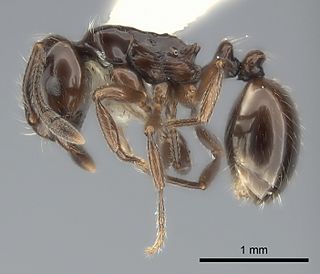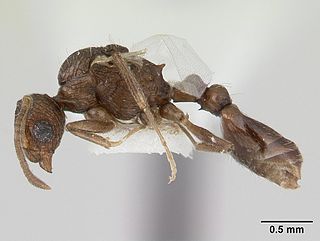Monomorium santschii is a species of ant that is native to Tunisia. The most famous species in the genus Monomorium is the highly invasive pharaoh ant, Monomorium pharaonis.

The red-crowned ant tanager is a medium-sized passerine bird from tropical America. The genus Habia was long placed with the tanagers (Thraupidae), but it is actually closer to the cardinals (Cardinalidae). Consequently, it can be argued that referring to the members of this genus as ant-tanagers is misleading, but no other common name has gained usage.

Adetomyrma venatrix, more commonly known as the Dracula ant, so named because of its grisly feeding habits of drinking the blood of its young, is an endangered species of ants endemic to Madagascar. Workers of this species are blind. The species was described as the type species of Adetomyrma in 1994, with the genus being an atypical member of its tribe.
Leptothorax pocahontas is a threatened species of ant endemic to Alberta, Canada, facing a high risk of extinction.
Lasius murphyi is a species of ant in the genus Lasius. It is endemic to the United States and Canada.

Monomorium bidentatum is a species of ant in the subfamily Myrmicinae. It is endemic to two South American countries, Chile and Argentina.
Camponotus universitatis is a species of ant in the genus Camponotus, the carpenter ants. It is native to Eurasia, where it has been recorded in Spain, France, Italy, Switzerland, Albania, Bulgaria, and Turkey.

Temnothorax brunneus is a species of ant in genus Temnothorax, that can be found in Algeria and Morocco.
Temnothorax kutteri is a species of ant in the genus Temnothorax. It is native to southern France and eastern Iberia, from the Pyrenees to the Sierra Nevada. The species parasitises other ant species in the genus Temnothorax.
Temnothorax sentosus is a species of ant in the genus Temnothorax, that is native to Kazakhstan.
Temnothorax inquilinus is a species of ant in the genus Temnothorax native to Ukraine.
Myrmecia inquilina is a species of ant endemic to Australia in the subfamily Myrmeciinae, first discovered in 1955 and described by Athol Douglas and William Brown Jr. in 1959. These ants are large, measuring 21.4 millimetres (0.84 in). During the time of its discovery, Douglas and Brown announced M. inquilina as the first social parasite among the primitive subfamilies, and today it is one of the two known Myrmecia species to have no worker caste. Two host species are known, Myrmecia nigriceps and Myrmecia vindex. Aggression between M. inquilina and its host species does not occur, and colonies may only produce M. inquilina brood months after the inquiline queens begin to lay their eggs. Queens eat the colony brood or trophic eggs, and other Myrmecia species may kill M. inquilina queens if they reject them. Due to its restricted distribution and threats to its habitat, the ant is "vulnerable" according to the IUCN Red List.
Oxyepoecus daguerrei is a species of ant in the genus Oxyepoecus. It is native to Argentina.

Oxyepoecus inquilinus is species of ant in the genus Oxyepoecus. It is endemic to Argentina. The species is listed together with two other Oxyepoecus species as "Vulnerable D2" by IUCN.
Pheidole acutidens is a species of ant in the genus Pheidole. It is endemic to Argentina.
Pheidole argentina is a species of ant in the genus Pheidole. It is endemic to Argentina.
Pheidole symbiotica is a species of ant in the genus Pheidole. It is endemic to Argentina.

Polyergus lucidus is a species of slave-making ant in the subfamily Formicinae endemic to the eastern United States. It is an obligatory social parasite, unable to feed itself or look after its brood and reliant on ants of another species of the genus Formica to undertake these tasks. Parasitic ants are known as "dulotics" and the ants they parasitise are known as "hosts".
Solenopsis solenopsidis is a species of ant in the genus Solenopsis. It is endemic to Argentina.

The Christmas Island shrew, also known as the Christmas Island musk-shrew is an extremely rare or possibly extinct shrew from Christmas Island. It was variously placed as subspecies of the Asian gray shrew or the Southeast Asian shrew, but morphological differences and the large distance between the species indicate that it is an entirely distinct species.








